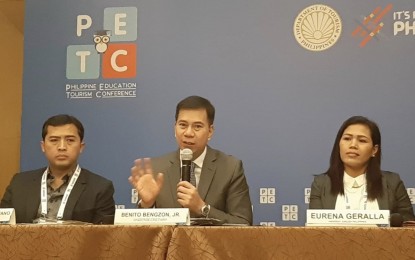
EDUCATION TOURISM. Department of Tourism (DOT) Undersecretary Benito Bengzon Jr. (center) answers questions during a press briefing on the sidelines of the 1st Philippine Education Tourism Conference (PETC) 2019 in Jpark Island Resort and Waterpark in Lapu-Lapu City, Cebu on Monday (July 29, 2019). With Bengzon are DOT-7 Regional Director Shahlimar Hofer Tamano and Eurenia Geralla, president of English Philippines. (PNA photo by John Rey Saavedra)
CEBU CITY – A high-ranking official of the Department of Tourism on Monday said the Philippines is gaining ground in education tourism and becoming a “Study English” destination of nationals from different countries of the world.
DOT Undersecretary Benito Bengzon Jr. underscored the competitive edge of the country as the third-largest English-speaking country in Asia with about 93.5 percent of its population speak and understand English, in opening up a new tourism brand anchored on education.
“It was until 2010 when we actually formalize the inclusion of education tourism, and obviously included ESL (English as second language) as among the priority products of the Philippine tourism industry,” Bengzon said in a press briefing on the sidelines of the 1st Philippine Education Tourism Conference (PETC) 2019 in Jpark Island Resort and Waterpark in Lapu-Lapu City, Cebu.
Bengzon identified Korea, China, Japan, Taiwan, Russia, Thailand, Indonesia, and Europe as emerging source markets of the country’s education tourism.
In his message to more than 300 participants of the conference, Bengzon said that in the test of English for international communication (TOEIC), the country’s mean score is 710, placing 10th worldwide and the highest among Asian countries.
“Being its official language in school and for business, Filipinos have gained proficiency to understand, write, speak and teach the language. English spoken by Filipinos has a neutral accent and is easily understood,” he said.
According to him, the country is one of the few countries in the world offering one-on-one English education, which is being preferred by foreign students as teaching strategy employed by the “Filipino teachers who are naturally nurturing, patient and understanding.”
Bengzon underscored the multi-faceted destinations in the country and the abundance of natural and man-made resources as added value in projecting the country as top destination of foreigners who wish to study English here.
He recognized as a challenge the native English-speaking countries like United Kingdom, Canada, and Australia as rising competitor in teaching ESL.
Shahlimar Hofer Tamano, regional director of the DOT-7 (Central Visayas), said in message delivered during the opening program of the conference that the region has 150 ESL centers registered and recognized by the Technical Education and Skills Development Authority (TESDA).
As of 2018, the Bureau of Immigration (BI) has issued 59,428 special study permits (SSP) to foreigners who wished to engage in short term study in the country, said Bengzon.
The figure is almost tripled over the last five years, as the BI had issued only 22,561 SSPs in 2013, he added.
Tamano, for his part said Cebu alone has 882 registered foreign students who are taking up varied courses in different higher education institutions (HEI). There are 165 HEIs in Central Visayas, 15 of which are declared as having maintained Center of Excellence and Center of Development.
Tamano said Cebu has been in the competitive edge because of the effort of the Duterte administration to open the Terminal 2 of the Mactan Cebu International Airport and the Panglao International Airport.
He said in 2018, around 10 international flights were inaugurated, with eight coming from China, including Macau.
“As of 30 April, Cebu has 595 international flights per week and 1,496 domestic flights weekly,” Tamano said.
He said that the DOT has accredited 17 training centers, including ESL schools, and 16 of these are located in Cebu. (PNA)
